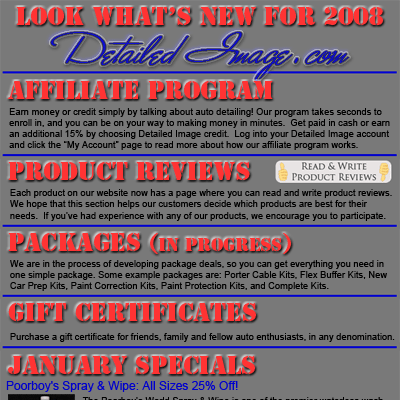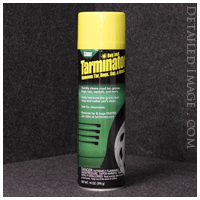Microfiber Packages for Any Detailer
January 23rd, 2008Microfiber towels and microfiber products have quickly become industry standard for high quality detailing. Microfiber towels have become the unsurpassed leader primarily because of their ability to safely collect particles. This may seem simple but no other material has even come close to achieving what microfiber has. Microfiber is essentially an ultra fine strand of yarn, made primarily from polyester. The material is approximately 1/100th of the thickness of a human hair, yet extremely strong. A cross sectional picture of one strand would look round, but it goes through a process that removes micro wedges from the strand. Upon completion a cross-sectional picture of one strand would look similar to an asterisk (*). This greatly increases the surface area of each strand and gives particles a place to easily collect. Best of all this material is totally safe to use on ultra delicate surfaces that can easily look dull with fine scratches and swirls. The microfiber products in these kits are washable too (check our guide to properly caring for microfiber). The microfiber towels included in these kits are made from the some of the finest microfiber strands available. Each one has a different weave which helps it specialize in certain kinds of tasks that are outlined below.
The All Purpose Microfiber Towel is probably the towel has the most versatility and uses. One of its ideal applications is removing clay lube, polishes, glazes, sealants and waxes from the clear coat. Polishes can be especially difficult to remove and a clean All Purpose Microfiber Towel makes that job much easier. Its low to medium nap gently collects particles while not risking harm to your finish. The All Purpose Microfiber Towel also works great with leather care, glass care, wheel care and so much more. This towel has virtually unlimited applications while caring for your automobile or home.
The Ultra Plush Microfiber Towel has a different texture on each side of the towel. One side has a low to medium nap and the other side has a thick nap. The thick nap makes this towel perfect for quick detailing, spray on sealants, spray on waxes and final wipe downs of sealants and waxes. The best part about this towel is how effectively it removes any one of these products from your paint. Don’t leave behind streaks and residue, remove the product right the first time with the Ultra Plush Microfiber Towel. This towel is also great for interior dustings, cleaning DVD and Navigation screens, coated hardwood and other delicate surfaces.
As the name insinuates the reTHICKulous Microfiber Towel is ridiculously thick and plush. No towel we have ever used or seen is even close to this towel. On average it’s three times heavier than a typical microfiber towel. It’s extremely thick and plush which makes it ideal to use on your most valuable and delicate surfaces. This towel is perfect to use on any delicate surface that you want to be absolutely sure no scratches are added to. You can use this towel on painted surfaces to remove almost every product. When you use a quick detailer to clean your paint this towel can safely absorb contaminants. It carefully glides across the surface and gently absorbs particles, ensuring nothing is grinded in to the surface. You may also want to use this towel on DVD and Navigation screens, coated hardwood, gauges, etc. Around the home this towel is perfect for TV screens, glasses, lap tops, fine china, collectibles and more! When you have to have the best this is the towel of choice!
Whether it’s applying your favorite wax or leather care the Microfiber Applicator Pad is a great product of choice. The inside of the microfiber applicator is a soft foam material that is wrapped in microfiber. Apply your favorite wax safely and easily with this applicator and rinse it clean when you’re done. It’s also great at applying leather care products or really any product that should be buffed on. No matter what you need to apply the Microfiber Applicator Pad is a great universal applicator for the job.
Drying your vehicle with old towels and rags is not only dangerous, but generally not too effective. The Microfiber Waffle Weave Drying Towel is the exact opposite because it’s super absorbent with it’s waffle weave texture and paint safe microfiber material. The towel is approximately 25” x 32” and will continuously soak up more and more water, holding up to 10 times its normal weight. Simply put it down on any area of your vehicle that is wet and watch how it aggressively soaks up all the moisture it can.
Clean and clear glass is key to seeing things early and driving safely. Cleaning the glass is easy, but leaving no streaks behind is the challenging part. The key is to spray your glass cleaner on one microfiber towel and clean the glass. Then use 1 – 2 Glass Microfiber Towels to remove the remaining residue. These towels have an extremely low nap and specialize in making solid contact with the glass and leaving no lint behind. The pressure you exert is more evenly distributed throughout the towel, so no residue can be passed over. With this process you’ll be amazed at just how crystal clear your glass can be.
A Two Sided Microfiber Polishing Towel will help you polish metal and clear coated surfaces like you have never polished before. One side of this towel is textured, while the other side is totally smooth. Apply metal polishes to the textured side and buff them on to metal wheels, trim, exhaust tips and more. This will release deeply embedded contaminants, oxidation, corrosion, brake dust and more. Next flip the towel over and use the smooth side to remove and remaining residue. This process will leave your metal surfaces with a luminous glow that is sure to catch the eye.
Microfiber Gloves are great products to have around for cleaning your vehicle and around the house. When you want to handle any delicate surface or clean with ease use these gloves. They are designed to fit any sized hand and clean virtually any surface. The unlimited applications of these gloves make them a perfect universal tool for detailers.
Treat your vehicle to the best car care products available with Detailed Image’s Microfiber Kits. These packages will help you get more out of each detail and take your detailing to the next level. You are sure to clean more effectively and safer with the top automotive detailing products. You’ll notice a dramatic difference in your results with your very first use and for years to come!








